UCV Civil War Military Operations Marker #21: Artillery duel near Charles Town, October 16, 1862
Introduction
Text-to-speech Audio
Images
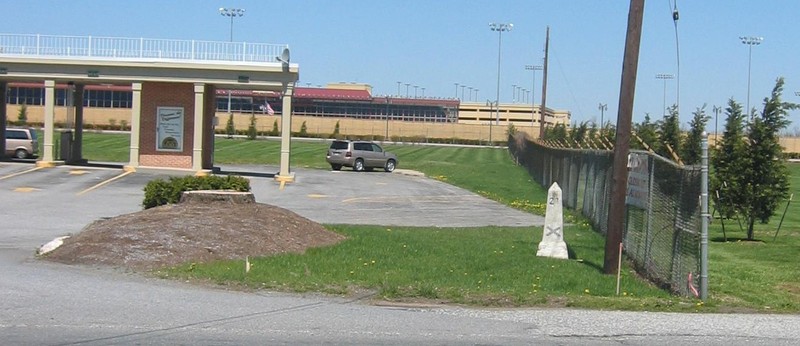
Union Major General Winfield S. Hancock
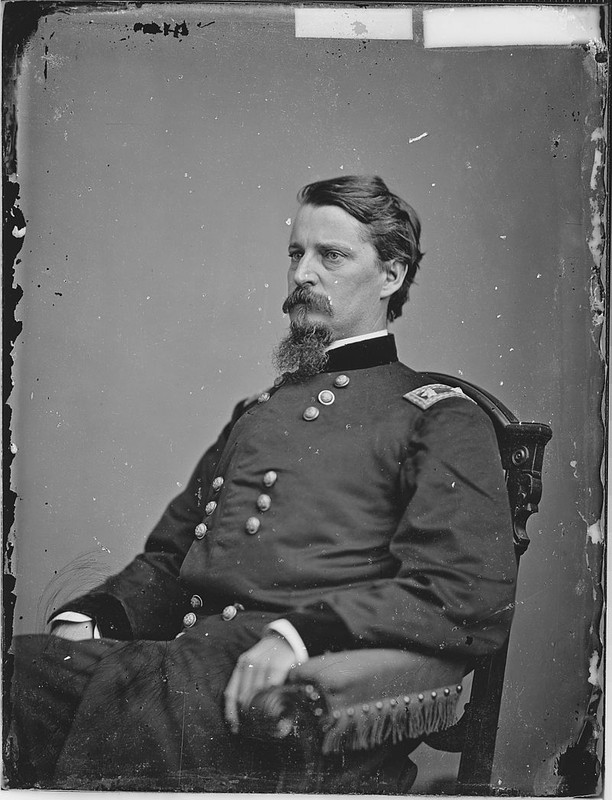
Confederate General T. T. Munford
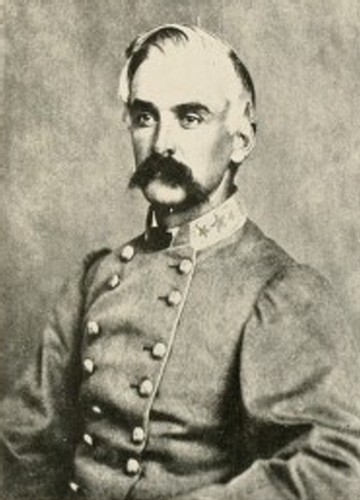
Official Records, page 1
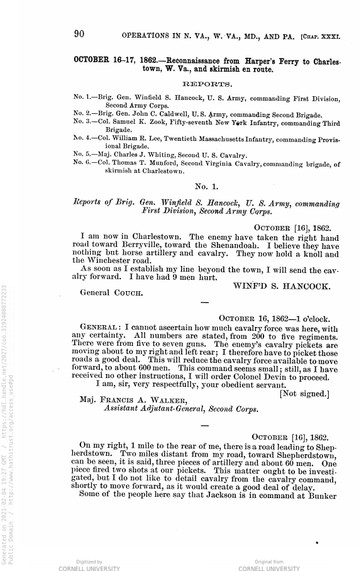
Official Records, page 2
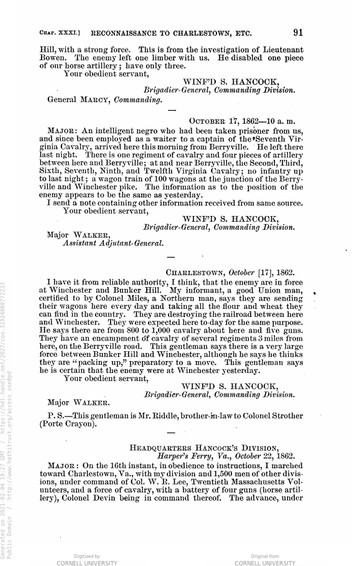
Official Records, page 3
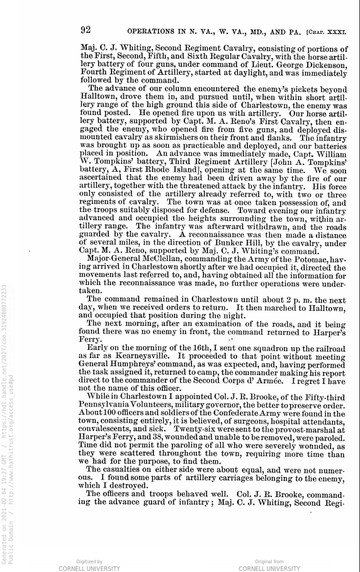
Official Records, page 4
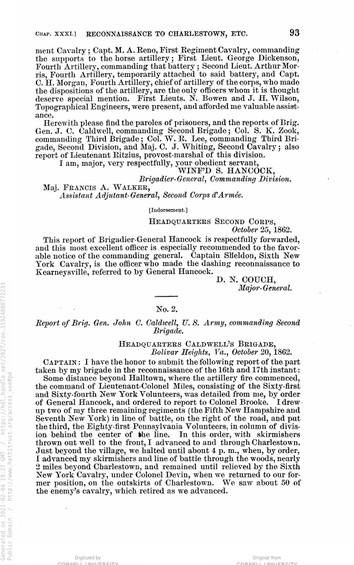
Official Records, page 5
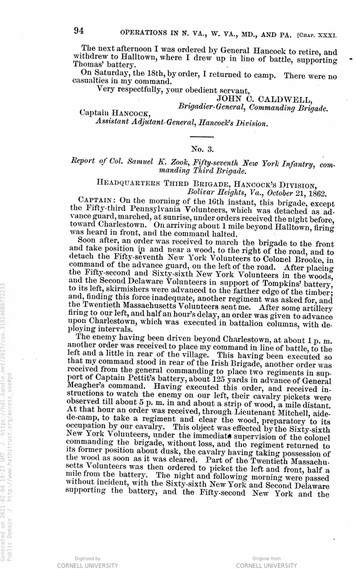
Official Records, page 6
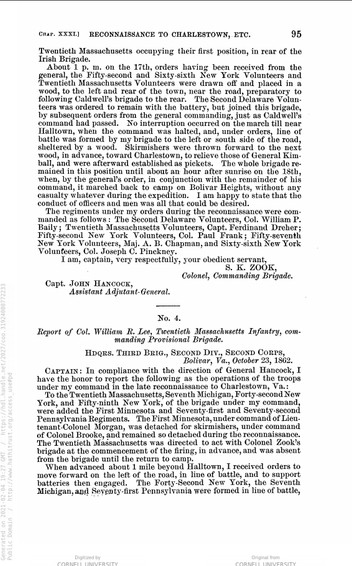
Official Records, page 7
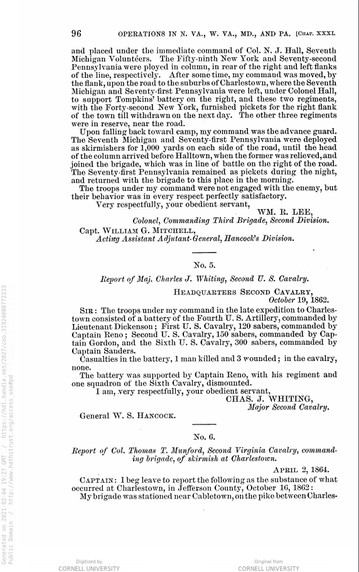
Official records, page 8
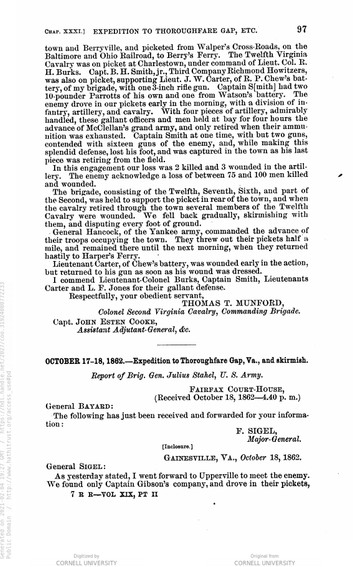
Backstory and Context
Text-to-speech Audio
In the aftermath of the Battle of Antietam, the armies of McClellan and Lee spent a few weeks resting in camp. The Army of the Potomac (McClellan) remained on the battlefield near Sharpsburg, MD while Lee’s Army of Northern Virginia took up camp near Bunker Hill, VA (WV). In mid-October, McClellan moved his army towards Harpers Ferry with the object to retake the town from the Confederate forces there. To screen the movements of the main Union army, forces under Brigadier General Andrew A. Humphreys and Brigadier General Winfield S. Hancock crossed the Potomac River and advanced towards Kearneysville and Harpers Ferry/Charles Town respectively.
Brigadier General Hancock crossed the Potomac on October 16th. Hancock’s brigade, plus 1,500 additional infantry, 4 regiments of cavalry, and 4 artillery guns crossed near Harpers Ferry and headed towards Charles Town. The Union force advanced so quickly, they were able to break through the Confederate pickets between North Mountain and the Shenandoah River. During the advance, Hancock’s force met resistance from Confederate pickets at Halltown but pushed them back to about 1 mile outside Charles Town. The Confederates—infantry under Lieutenant John W. Carter and guns of R. P. Chew’s battery and the Richmond Howitzers—put up resistance on high ground outside Charles Town. Hancock’s Union troops were able push the Confederate troops back into Charles Town and ultimately forced them to evacuate the city. Union forces remained in Charles Town overnight and then returned to Harpers Ferry on October 17.
The other force of this action under Brigadier General Humphreys crossed the Potomac at Butler’s Ford near Shepherdstown on October 16th with 6,000 infantry of the Fifth Corps, 500 cavalry, and 6 pieces of artillery. A few miles past Shepherdstown Humphreys’ forces met resistance from Confederate forces under Major General J.E.B. Stuart. Stuart’s men had been destroying part of the Baltimore & Ohio Railroad at Thompson’s Stephenson’s Station about six miles from Smithfield (now Middleway). In the late evening of the 16th there was an engagement between these two forces and after about 15 minutes of fighting the Confederate force retreated. The following morning, October 17, Humphreys continued his march towards Leetown and met more resistance just outside of Kearneysville. After a small engagement near Kearneysville, the Federal troops started to retreat back towards Shepherdstown and their camp at Sharpsburg. According to Confederate accounts, the Confederate resistance forced the Union troops to fall back and retreat across the Potomac to safety. According to Humphreys’ report of October 19, 1862 he received directions that the objective of their offensive was complete and both his force and that under Hancock would withdraw simultaneously. In the evening of October 17 Humphreys’ forces recrossed the Potomac towards their original camp at Sharpsburg.
After this action of October 16-17, 1862, McClellan’s army retook Harpers Ferry and engaged in expeditions against Confederate forces and guerillas before the Army of the Potomac moved back into eastern Virginia before the Battle of Fredericksburg.
About the Monuments:
This series of monuments and accompanying tour pamphlet were part of an initiative from the Jefferson County Camp, United Confederate Veterans to commemorate the 50th anniversary of the Civil War. In 1910 Col. R. Preston Chew and the Jefferson County UCV raised the funds to place 25 concrete obelisks in Jefferson County to mark locations of engagement or other significant events. The following year the Camp published a pamphlet to accompany the obelisks and give more information about each location. This was Military Operations in Jefferson County, Virginia (Now West Virginia), 1861-1865 published in 1911. The pamphlet has been reprinted several times by the Henry Kyd Douglas Camp, No. 199 of the Sons of Confederate Veterans. Because the monuments and accompanying pamphlet were done by Confederate veterans it is likely that the locations and descriptions are biased towards or favor the Confederate view and experience of the war.
Original Text from the 1911 Pamphlet:
"Marker Number Twenty-One
Artillery Duel at Old Fair Grounds Near Charles Town
After the battle of Sharpsburg, McClellan remained north of the Potomac for about thirty days, when he crossed below Harpers Ferry with his artillery on October 16, 1863. To screen that movement he sent Hancock with a large force of infantry, cavalry and artillery to make a reconnaissance in the direction of Charles Town. Our cavalry under the command of General T. T. Munford retired before this force until they reached a point about half a mile below Charles Town, known as the Old Fair Grounds. Here a section of Chew’s Battery under Lieutenant J. W. Carter and two guns of the Richmond Howitsers, third company under Captain B. H. Smith were placed in position, and opened on the enemy, who had planted their batteries on the hill about three quarters of a mile below, known as Butler’s Hill.
A severe engagement between the artillery on either side took place at this point, although the enemy were greatly superior in number and guns. The Confederate guns soon got the range and inflicted serious damage upon the enemy. The resistance on their part was so bold and determined that the Federals were delayed for several hours, and after the retirement of the guns they occupied Charles Town until the next day when they retired to Harpers Ferry.
Lieutenant J. W. Carter, who was greatly distinguished as an artillery officer and a man of superb courage and daring, was noticed in Official Report by General Munford, and recommended for promotion. Our forces retired towards Berryville undisturbed by the enemy."
Cite This Entry
Historic Landmarks Commission, Jefferson County and Kathleen Thompson. "UCV Civil War Military Operations Marker #21: Artillery duel near Charles Town, October 16, 1862." Clio: Your Guide to History. February 17, 2021. Accessed March 24, 2025. https://theclio.com/entry/77334
Sources
Bushong, Millard Kessler. A History of Jefferson County, West Virginia. Charles Town, WV: Jefferson Publishing Company, 1941.
Engle, Stephen Douglas. Thunder in the Hills: Military Operations in Jefferson County, West Virginia, During the American Civil War. Charleston, WV: Mountain State Press, 1989.
Military Operations in Jefferson County Virginia (and West Va.) 1861-1865. Published by Authority of Jefferson County Camp U.C.V. Farmers Advocate Print, 1911. Accessed January 20, 2021. https://babel.hathitrust.org/cgi/pt?id=uc2.ark:/13960/t4vh5gp6c&view=1up&seq=5.
Report of October 19, 1862 by A. A. Humphreys. Official Records of the War of the Rebellion Series 1, Vol. 19, pt. 2, pp. 85-88. “Timeline of West Virginia: Civil War and Statehood: October 16-17, 1862.” Child of the Rebellion: An Archives and History Sesquicentennial Project. West Virginia Department of Arts, Culture and History. Accessed January 20, 2021. http://www.wvculture.org/history/sesquicentennial/18621017.html.
Theriault, William D. History of Eastern Jefferson County, West Virginia. Hagerstown, MD: Published by the Author, 2009. Jefferson County Historic Landmarks Commission. Accessed January 20, 2021. http://jeffersoncountyhlc.org/wp-content/uploads/2016/03/Chapter_11.html.
"Winfield Scott Hancock." Wikipedia. Accessed February 4, 2021. https://en.wikipedia.org/wiki/Winfield_Scott_Hancock.
"Thomas T. Munford." Wikipedia. Accessed February 4, 2021. https://en.wikipedia.org/wiki/Thomas_T._Munford.
The War of the Rebellion: a Compilation of the Official Records of the Union and Confederate Armies. Series.1:vol.19:pt.2:Reports Correspondence. p. 90-97. Accessed February 4, 2021. https://babel.hathitrust.org/cgi/pt?id=coo.31924077699886&view=1up&seq=3.
The War of the Rebellion: a Compilation of the Official Records of the Union and Confederate Armies. Series.1:vol.19:pt.2:Reports Correspondence. p. 90-97. Accessed February 4, 2021. https://babel.hathitrust.org/cgi/pt?id=coo.31924077699886&view=1up&seq=3.
The War of the Rebellion: a Compilation of the Official Records of the Union and Confederate Armies. Series.1:vol.19:pt.2:Reports Correspondence. p. 90-97. Accessed February 4, 2021. https://babel.hathitrust.org/cgi/pt?id=coo.31924077699886&view=1up&seq=3.
The War of the Rebellion: a Compilation of the Official Records of the Union and Confederate Armies. Series.1:vol.19:pt.2:Reports Correspondence. p. 90-97. Accessed February 4, 2021. https://babel.hathitrust.org/cgi/pt?id=coo.31924077699886&view=1up&seq=3.
The War of the Rebellion: a Compilation of the Official Records of the Union and Confederate Armies. Series.1:vol.19:pt.2:Reports Correspondence. p. 90-97. Accessed February 4, 2021. https://babel.hathitrust.org/cgi/pt?id=coo.31924077699886&view=1up&seq=3.
The War of the Rebellion: a Compilation of the Official Records of the Union and Confederate Armies. Series.1:vol.19:pt.2:Reports Correspondence. p. 90-97. Accessed February 4, 2021. https://babel.hathitrust.org/cgi/pt?id=coo.31924077699886&view=1up&seq=3.
The War of the Rebellion: a Compilation of the Official Records of the Union and Confederate Armies. Series.1:vol.19:pt.2:Reports Correspondence. p. 90-97. Accessed February 4, 2021. https://babel.hathitrust.org/cgi/pt?id=coo.31924077699886&view=1up&seq=3.
The War of the Rebellion: a Compilation of the Official Records of the Union and Confederate Armies. Series.1:vol.19:pt.2:Reports Correspondence. p. 90-97. Accessed February 4, 2021. https://babel.hathitrust.org/cgi/pt?id=coo.31924077699886&view=1up&seq=3.

